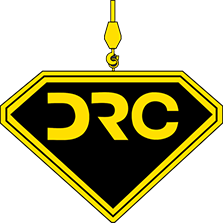In the complex world of crane and rigging, success hinges on precision and skill. As we begin this exploration, we dive into the diverse realm of rigging – an art that goes beyond functionality, evolving into its science. Come along as we uncover the details of different rigging techniques, highlighting the expertise of Diamond Rigging and Crane. This sets the stage for a deep dive into various rigging types that are crucial for safe and efficient crane operations.
Understanding Rigging Operations
Rigging is the unseen choreography behind successful crane operations. Riggers secure and unsecure heavy loads before the cranes of an operation move them. At Diamond Rigging and Crane, we recognize the pivotal role of rigging in ensuring safety and efficiency.
Proper rigging isn’t just about tasks; it’s a strategic dance between equipment and expertise. It’s the linchpin that turns theoretical knowledge into tangible results. Safety and efficiency are non-negotiable, and this is where training becomes crucial.
Training transforms novices into adept riggers, teaching not just ‘how’ but ‘why.’ As we explore rigging operations, let’s appreciate that it’s more than mechanics; it’s a symphony ensuring every lift is a masterpiece of safety and efficacy. Now, let’s delve into understanding the core of rigging operations.
Basic Rigging Components
Let’s shed light on its fundamental building blocks: slings, shackles, and hooks. These components play a pivotal role in crafting a secure rigging setup. They ensure the reliability and safety of every lift.
Slings: These versatile straps form the backbone of lifting operations, cradling the load securely. From synthetic web slings to chain slings, each type serves a specific purpose, contributing to the stability of the rigging arrangement.
Shackles: Often overlooked but indispensable, shackles act as the linchpin connecting various elements. Their robust design and varied configurations make them a fundamental link, reinforcing the integrity of the rigging system.
Hooks: The point of contact between the crane and the load, hooks demand precision and strength. From clevis to swivel hooks, understanding their functions is paramount for a secure lift.
Statistics echo the significance of these basic components. Accidents are risks mitigated by the proper use of slings, shackles, and hooks. As we delve into the details, let’s appreciate the foundational role these components play in enhancing both safety and efficiency in rigging operations.
Common Types of Rigging Configurations:
As we continue our exploration of rigging, let’s unravel the common configurations that form the backbone of lifting operations. Each configuration has its unique strengths and applications, contributing to the adaptability and efficiency of rigging setups.
Vertical Hitch
This straightforward configuration involves attaching the load vertically. It’s ideal for lifting objects that have a stable, single-point attachment. When precision and control are paramount, the vertical hitch takes center stage, ensuring a direct and secure lift.
Basket Hitch
Imagine cradling the load within the sling, and you have the basket hitch. Perfect for lifting cylindrical objects or loads with many attachment points, the basket hitch excels in evenly distributing the load’s weight, minimizing the risk of imbalance.
Choker Hitch
In scenarios where a load needs to be tightly secured, the choker hitch comes into play. It involves looping the sling around the load and attaching it to itself. While effective in certain situations, it’s essential to be mindful of its limitations, particularly in handling irregularly shaped or delicate loads.
Bridle Hitch
Versatility defines the bridle hitch, allowing for multiple attachment points. By connecting the load to multiple lifting points, this configuration distributes the weight evenly, making it an excellent choice for irregularly shaped loads or those with off-center centers of gravity.
Understanding these common rigging configurations equips riggers with the knowledge to choose the most suitable approach for each unique lifting task. As we delve into the intricacies of rigging, let’s appreciate the advantages each configuration brings to the lifting table.
Specialized Rigging Techniques
Now that we have covered the basics, let’s talk about the various rigging techniques we use in this industry.
Multi-Leg Bridles
When complexity arises, the multi-leg bridle steps in. This technique involves using multiple slings to create a bridle, distributing the load evenly across various points. Its advantage lies in its ability to handle irregularly shaped or heavy loads, providing a balanced and controlled lift.
Articulated Pick Points
Rigging is not a rigid science; it’s an art that demands adaptability. Articulated pick points offer just that. By allowing for movement and adjustment during the lift, this technique accommodates shifts in load position, ensuring a stable and controlled operation, especially when dealing with dynamic or unpredictable loads.
Load Angle Factors
Understanding load angles is akin to deciphering a safety code in rigging. The angle at which the load is lifted significantly influences the stress on the rigging components. A shallow angle may appear less challenging, but it can introduce additional forces. Delving into load angle factors is not just a technicality; it’s a strategic move to enhance safety and prevent unforeseen complications during lifting operations.
These methods showcase the finesse and adaptability required in rigging operations. True mastery lies in the ability to navigate the complexities of each lift with precision and expertise.
Advanced Rigging Applications
There are various applications of rigging in our industry. Let’s talk about some of the more advanced fields a rigger could work in.
Heavy Lift Rigging
In the realm of heavy lift rigging, where loads reach substantial proportions, considerations extend beyond the ordinary. Explore the unique challenges posed by massive loads and delve into the meticulous planning and execution required to ensure safety and success in heavy lift operations.
Offshore Rigging
Offshore environments present a distinctive set of challenges for rigging professionals. Dive into the complexities of rigging at sea, where factors like corrosion, dynamic loads, and unpredictable weather demand a specialized approach. Uncover the solutions employed in offshore rigging to ensure seamless operations in these challenging settings.
Entertainment Rigging
Rigging transcends the construction industry, finding a vibrant application in entertainment. Explore how rigging takes center stage behind the scenes of concerts, theatrical productions, and events. Delve into the nuances of entertainment rigging, where precision and safety are paramount in creating awe-inspiring spectacles.
Training for Rigging
Transitioning from the application to the acquisition of rigging skills, let’s focus on the critical aspect of training that shapes competent riggers.
Diamond Rigging and Crane’s Approach
At the heart of rigging excellence is training, and Diamond Rigging and Crane stand as a beacon of commitment to comprehensive education. Uncover the school’s approach, emphasizing hands-on learning, theoretical expertise, and real-world simulations to mold individuals into adept rigging professionals.
Industry Standards
Rigging proficiency goes hand in hand with adherence to industry standards. Highlight the paramount importance of aligning training programs with these regulations, ensuring that riggers are not just skilled but also equipped with the knowledge to uphold safety and quality in their practices.
Trust Diamond Rigging
As we explored the world of rigging, we discovered its key elements, various setups, and advanced techniques. Rigging isn’t just about lifting; it’s a vital skill in industries like heavy lifting, offshore work, and entertainment. Diamond Rigging and Crane’s strong commitment to thorough training ensures professionals become true masters of rigging. This journey reveals that rigging goes beyond lifting – it’s about precision, safety, and understanding intricate details that elevate industries. With the right knowledge and training, the rigging landscape opens up boundless opportunities.
Contact us to sign up for our rigging training courses today!


